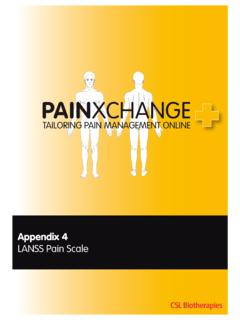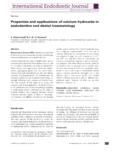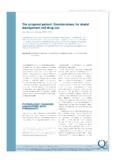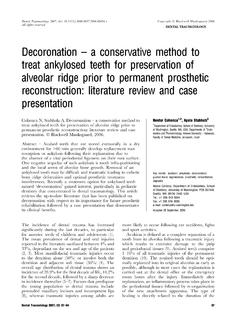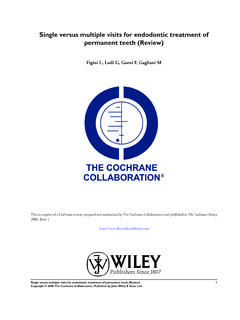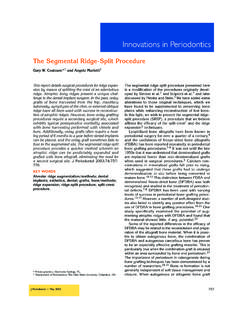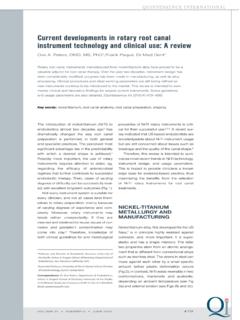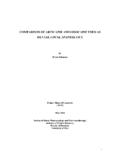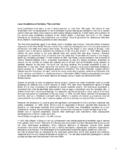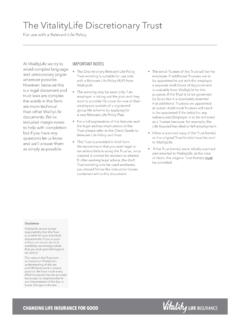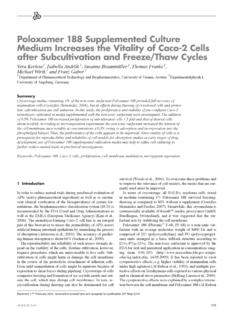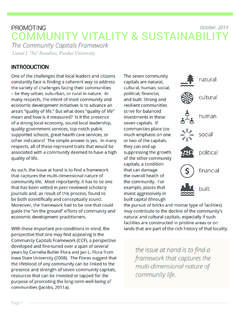Transcription of Assessment of pulp vitality: a review - EndoExperience
1 2008 The AuthorsJournal compilation 2008 BSPD, IAPD and Blackwell Publishing Ltd 3 DOI: Blackwell Publishing Ltd Assessment of pulp vitality : a review VELAYUTHAM GOPIKRISHNA, GALI PRADEEP & NAGENDRABABU VENKATESHBABU Department of Conservative Dentistry and Endodontics, Meenakshi Ammal Dental College, Chennai, India International Journal of Paediatric Dentistry 2009; 19: 3 15 Background. One of the greatest diagnostic chal-lenges in clinical practice is the accurate assessmentof pulp status. This may be further complicated inpaediatric dentistry where the practitioner is facedwith a developing dentition, traumatized teeth, oryoung children who have a limited ability to recalla pain history for the tooth in question.
2 A varietyof pulp testing approaches exist, and there may beconfusion as to their validity or appropriateness indifferent clinical situations. Aim. The aim of this paper is to provide the clinicianwith a comprehensive review of current pulptesting methods. A key objective is to highlight thedifference between sensitivity testing and vitalitytesting. A biological basis for pulp testing is alsoprovided to allow greater insight into the inter-pretation of pulp testing results. The rationale for,and methods of, assessing pulpal blood flow aredescribed. Introduction Diagnosis in dentistry may be defined as theprocess whereby the data obtained fromquestioning, examining and testing are combinedby the dentist to identify deviations from thenormal 1.
3 The diagnosis of dental pulp statusshould be seen as a synthesis of history, clin-ical examination, special tests, and radiologicalexamination, and not as the outcome of anyone specific test. vitality testing is an impor-tant aid in the diagnosis of pulp disease andapical periodontitis. If the pulp is deemed tobe severely compromised as a result of thediagnostic testing, then endodontic treatment,or indeed extraction, may be 2 has proposed three key uses of pulptesting in clinical practice: 1) Prior to operative procedures : pulp testing maybe indicated for selected teeth prior torestorative or orthodontic interventions,particularly where pulp health may be inquestion.
4 The absence of symptoms or radi-ographic changes alone may not be takenas conclusive evidence of pulp vitality ,because pulpal degeneration can occurwithout accompanying symptoms 3 . 2) Diagnosis of pain : The origin of most oralpain is pulpal 2 , but pain localization may bedifficult, and may require a full range oftests as well as a careful history and exam-ination. A number of authors haveacknowledged the value of pulp testing in thediagnosis of pain in the trigeminal area 4,5 .Furthermore, case reports have illustratedthe value of pulp testing in identifying pul-pal pain from other conditions such asmyofascial pain dysfunction syndrome 6 and referred pain 7.
5 Conversely, a normalresponse to pulp testing may eliminate thediagnosis of pulpal pathology in oro-facialpain of unknown aetiology. 3) Investigation of radiolucent areas : Radiolucentareas at the apices of teeth may be theresult of periapical extension of pulpalpathology, but may also be due to otherpathological processes, or may, in fact, rep-resent normal structures. If pulpal patho-logy is not responsible for the lesion, theassociated teeth would be expected to givea normal response to vitality testing. Peri-odontal lesions, cysts, fibrous lesions, con-genital abnormalities, and even neoplasticprocesses may all produce periapical radi-olucencies similar to those associated withpulp degeneration 7,8.
6 The mental foramenand the incisive canal are two normal Correspondence to: Gopikrishna Velayutham, Meenakshi Ammal Dental College Department of Conservative Dentistry and Endodontics, Maduravoyal, Chennai 600010, India. E-mail: 4 V. Gopikrishna et al. 2008 The Authors Journal compilation 2008 BSPD, IAPD and Blackwell Publishing Ltd structures which may also present asperiapical addition to the mentioned uses, Mumfordand Bjorn 4 suggest three further uses for pulptesting: 1) Post-trauma Assessment : vitality testing formsan important part of the examination andreview of traumatized teeth. However, thevalidity of test results is controversial andwill be discussed fully in a later testing is also important in determin-ing the treatment needs of teeth involved injaw fractures 9 , and those affected by surgicaltrauma, such as subapical osteotomy 10 orvital transplantation procedures 11.
7 2) Assessment of anaesthesia : Grossman advocatedthe use of pulp testers to assess whether atooth is completely anaesthetized followinginjection of local anaesthetic prior to oper-ative procedures 12 . This would, however,seem unnecessary in normal clinical prac-tice. It has also been suggested that pulptesting may be a useful adjunct in experi-mental studies which specifically seek toevaluate the effectiveness of differentanalgesic drugs 4 . 3) Assessment of teeth which have been pulp cappedor required deep restoration : The prognosis ofteeth which have been pulp capped orrequired deep restorations is clinicallyassessed on the basis of reported symptoms;clinical palpation; and percussion, radio-graphs, and pulp testing.
8 Thus, vitalitytesting may play an important role indetermining the outcome of various pulp -capping procedures. vitality Assessment methods The ideal pulp test should provide a simple,objective, standardized, reproducible, non-painful,non-injurious, accurate, and inexpensive wayof assessing the condition of the pulp endodontics, pulp testing strategies mayinvolve sensitivity tests such as thermal orelectric pulp testing (EPT) which assess whetherthere is response to a stimulus. These are themost common methods employed by other form of pulp testing is to evaluatethe tooth s vascular supply by using laser Dopplerflowmetry (LDF) or pulse oximetry. Pulpal innervation It is important to have an understanding ofpulpal innervation characteristics in order toappreciate the rationale for, and mechanismsinvolved in, tests of pulpal sensitivity.
9 Withinthe coronal pulp , nerve bundles diverge andbranch out towards the pulpo-dentine border,and emerge from their myelin sheaths 13 15 .Nerve divergence continues until each bundlelooses its integrity and smaller fibre groupstravel towards the dentine. This course is rel-atively straight until the nerve fibres form aloop and a resultant mesh termed the nerveplexus of Rashkow. Terminal axons exit fromtheir Schwann cell investiture and pass betweenthe odontoblasts as free nerve endings 15 . Thisnerve plexus is most well developed in theperipheral pulp along the lateral wall of coronaland cervical dentine, and along the occlusalaspect of the pulp types of sensory fibres are present inthe pulp : the myelinated (A fibres) and unmy-elinated C fibres.
10 The A fibres predominantlyinnervate the dentine and are subgroupedaccording to their diameter and conductionvelocities into A and A fibres. The A fibresmay be more sensitive to stimulation thanthe A fibres, but functionally these fibres aregrouped together. Approximately 90% of Afibres are A fibres. The C fibres innervate thebody of the pulp . The A fibres have lowerelectrical thresholds than the C fibres, andrespond to a number of stimuli which do notactivate C fibres 16 . A fibres mediate acute,sharp pain and are excited by hydromechani-cal events in dentinal tubules such as drillingor air-drying 17 .The C fibres mediate a dull, burning, andpoorly located pain, and are activated only bystimuli reaching the pulp proper 18,19.
